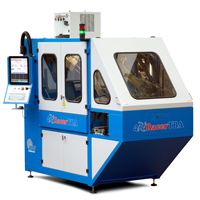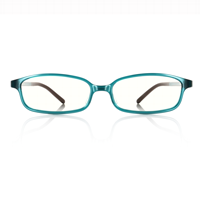SYSTEMS / EQUIPMENT
MEI’s RacerTBA Offers Small Footprint, High Efficiency and Reliability
 |
Top Line: RacerTBA is the latest ophthalmic lens edging unit designed and developed by MEI System. It combines the TBA (Throw the Block Away) inspection process and the edging system in one single unit and has an industrial design that makes it extremely compact and highly reliable. By combining the indexed rotating table concept with the experience of MEI in CNC machines, RacerTBA increases productivity while maintaining the same accuracy and consistent precision as other MEI products.
Close Up: RacerTBA performs two operations: lens loading and inspection, and edging. By using an indexed rotating table with four positions for each side, the two operations are carried out simultaneously allowing RacerTBA to process eight lenses at the same time and making it the fastest edging machine on the market. The first productivity tests show that the machine can process about 150 lenses per hour (1,200 lenses/eight-hour shift).
Although designed for large-scale production, the lens edging side of the RacerTBA unit has six spindles and six tools to guarantee the typical flexible processing found in all MEI units: vertical and inclined bevel, flat edge, grooving, drilling (as well as non-through drilling), polishing (flat and bevel edge), square bevel (T), step back on bevel, groove and chamfer.
A key benefit of RacerTBA is the significant reduction in production costs that derives from eliminating the blocks, adhesives and protective films used in traditional grinding as well as integrating lens quality inspection into the machine. Because no manual processing or handling is required, a great deal less space is required than is currently necessary when automated lens blocking processes are used.
Vital Stats: The fundamental difference between RacerTBA and the standard BispheraTBA unit—in addition to its increased productivity—lies in the evolution of the TBA lens orientation system. The version installed in the new RacerTBA carries out full quality inspection on all lenses (single vision, progressive, bifocal, gradient tinted, polarized, etc.) by means of a new mobile lensmeter integrated into the control process and thickness detection. The precision of power checks is 0.03 diopters for single vision lenses and 0.05 diopters for progressives. With this unit, preliminary inspection of lenses to be edged are no longer needed (whether stock or prescription lenses): once the lenses have been positioned inside the trays, the unit performs all the processes automatically, producing inspected and edged lenses.
www.meisystem.com; (847) 357-0323
| Top | |
| Send your comments to VM |
Eye²
Jins Eyewear to Launch Glasses That Reduce Digital Eye Strain Caused by Blue Light
 |
Top Line: Jins Screen from Jins Eyewear is designed to combat the effects of blue light from prolonged use of digital devices, including computer screens and smartphones, by filtering blue light and helping ease digital eye strain. Originally launched as Jins PC in Japan in 2011, Jins has sold more than five million pairs of Jins Screen glasses. Jins will introduce the glasses to the U.S. market on August 8. “Our goal is to improve people’s lifestyles with glasses, by making them less about vision correction and more about changing the way people perceive the world around them. That is why we continue to introduce new functional eyewear like Jins Screen,” said Hitoshi Tanaka, CEO of Jin Co., Ltd.
Close Up: To block the overexposure of blue light and combat eye health concerns, Jins Screen lenses reduce the transmission of light in the 460 nm range by 25 percent via two pathways: coating and substrate. Certain wavelengths of blue light are reflected by the patented coating on the lenses, while others are absorbed by the substrate, which is made of a compound that absorbs certain wavelengths of blue light. As a result, Jins Screen also reduces eye fatigue. A clinical study conducted by JINS and Keio University in Japan in 2011 showed a significant difference in the decrease of Critical Flicker Frequency (CFF), an index used to measure eye strain. The index works by flashing a blinking light at an increasing speed in front of the subject’s eyes. The faster the speed of the light they can detect, the less strained their eyes are. Subjects wearing Jins Screen exhibited a smaller reduction in baseline CFF than those who weren’t wearing the glasses. Jins Screen is designed with the comfort and style of the consumer in mind. The clear lenses make the glasses indistinguishable from regular eyewear and the lightweight Airframes are comfortable to wear all day. Jins is encouraging consumers to share photos of themselves on social platforms wearing their Jins Screen using #blockoutblue.
Vital Stats: Jins Screen will be available for purchase in a range of colors beginning on August 8 coinciding with the grand opening of the Jins U.S. flagship store in San Francisco’s Union Square. Additionally, Jins Screen will be available for purchase online at: http://www.jins.com/. Starting on August 8, square-shaped, pre-packaged JINS SCREEN glasses will be available in eight colors for $60. The Wellington-shaped glasses will follow in the fall and will cost $80. Additionally, there will be an option to add Jins lenses to any of the 1,200 frames available in-store and online for an additional $60.
www.jins.com
| Top | |
| Send your comments to VM |
WEB TECH
Shamir Offers ECPs Practice-building Tips on New Blog
 |
Top Line: Freeform progressive lens maker Shamir is launching a blog designed to help eyecare professionals improve their practice(s). Shamir’s Vitamin See blog, which features a new post each week, focuses on tips to help ECPs in all aspects of their practice, including staff education and merchandising tips. Live as of June 11, 2015, ECPs can now visit www.theVitaminSee.com for essential practice-building tips.
Close Up: The Vitamin See blog has been designed to provide eyecare professionals and their staff with new, unique, and highly useful information that will help increase their business. Shamir notes that practice-building tips are crucial in today’s competitive environment where consumers are highly educated and more is expected of their sales staff—81 percent of consumers today do online research before making a big purchase, and sales associates report two times higher job satisfaction if they can meet customers’ needs. “We are pleased to offer such an accessible and useful resource to ECPs. With the Vitamin See blog we strive to provide valuable information practices can implement immediately. We look forward to this blog becoming a must-read every week for ECPs,” said Mark Becker, Shamir’s vice president of marketing and strategic partnerships.
Vital Stats: The blog features four main topics for posts including: Business Strategies, Trends, Merchandising Tips, and Staff Education. ECPs can also sign up to receive the Vitamin See blog posts directly to their inbox.
www.theVitaminSee.com
| Top | |
| Send your comments to VM |
